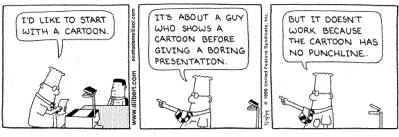So we took a survey: “What Makes You Run from the Classroom”
The results of this three question, unscientific, “scratch the surface” survey has been interesting and makes me consider building another one that takes a deeper dive regarding classroom facilitation. There were 236 responses. I did not break it down by demographic. I just simply wanted to know what people thought about common classroom missteps, how badly do these missteps affect the audience? As suspected, the information here reinforces what every good presenter should already know.
The first question was based on presentation skills.
Receiving the highest marks, with no surprises, – meaning more people felt these areas, when abused, had the potential to ruin the learning experience:
- “Preaching” rather than teaching”: We have all been there when the presenter is “Kicking a dead horse” or “Preaching to the Choir”. We need to be aware of when we cross the threshold from teaching to preaching and move on.
- “Presenter talks to (or reads) the slides”. This surprised me, I thought this would be at the very top the list of things we hate the most, it certainly tops my list. Apparently we hate to be “preached” at more.
- “Presenter is a “know-it-all”. I recently overheard a conversation, a group of young adults had seemingly came from a training session. They were talking about the presenter: Person A: “You couldn’t get a word in edgewise”. Person B “What did it matter, if you weren’t agreeing with him he didn’t want to hear from you anyway.” This conversation actually happened, talk about serendipity! Remember your audience has thoughts, the learning process is all about bringing those thoughts out, sharing them with the group and having a healthy discourse. The participants may not agree with you, and that’s okay. Open up the conversation to everyone it may be the most interesting thing that happens all day.
- Tied for #3: “Didn’t allow for interactivity”. Didn’t involve the audience. People want to interact with you, and with others. Build in activities that allow for a or even provoke a debate. We don’t need people to get up and sing and dance more, we need to engage the mind and the body. Be sure your activities relate to the topic. Create round-robins to encourage peer discussion, build in teach-backs to reinforce knowledge exchange.
- “Presenter only stays behind the lectern”. I was really surprised here, I thought this would be higher on the list – but when there were so many other things to be annoyed with… Let this be lesson to you – When I go into a classroom as the facilitator and see a lectern set-up I move it far, far, away. I’ve come across circumstances where the lectern couldn’t be moved – that’s okay, I used it to hang flipcharts from, turning it from the “podium of death” to a designer platform.
- “Presenter walks around too much”. This made sense to me. Who are you running from? There is a delicate balance between never moving and looking like you have fire ants in your pants. If you are unsure of the answer, this is something that can be addressed in your end of day evaluation (you conduct one right?), ask if you move around too much. It’s a simple Yes or No. If yes, cut down on the caffeine or Red Bull in the morning.
The second question was about the presentation itself and course materials.
- “Slides have too much text/font is too small”. If you have to say, “I know those of you in the back will have trouble reading this slide…” then you need to rewrite the slide. Get rid of the bullets, there are a bazillion ways to more display a list that is far more interesting than a bulleted list. Keep the font to a 24. While we are at it, never, ever, cut and paste an excel spread sheet into a PPT slide. JUST.STOP.IT.
- “Silly or random games”. Games/challenges/activities need a purpose. Games should ALWAYS be tied back to the lesson. Activites need to support the learning, otherwise you are wasting time. Be sure to debrief the activity, even if it’s a simple call back to the group. “Tell me why we just did this activity? What points are we connecting, what did you learn?”
- “Too many slides”. Really, it’s all about the content. You can have 50 slides if the content is solid and well spaced out. People don’t want 50 slides of excel spreadsheets or have slides crammed with text and clipart. Your tip for the day – Hide the slide numbers on the deck, you don’t need them, they don’t need them. (you can hide them) Especially do not use the “slide X out of Y” formatting. How painful is it to know that you are only on slide 20 out of 250. YIKES.
- “They don’t need a handout of the deck”. Good, save some trees. But seriously, if you have created a killer deck, then the deck is no good without you. What your people need is a solid participants guide, with resources, references and plenty of white space for notes. (No, not the PPT deck printed out with 3 lines besides it, that is not a participant guide.)
- “They cannot read the writing on a flip chart”. This did not surprise me. If the presenter is going to write on a flip chart make it legible. As professionals, if we are going to take the time to write something down, – then people should be able to read it. Practice the skills of writing while facing an audience, your people will thank you for it. If your writing is that bad, pre-write the charts before your session.
The third and last question was just general presentation stuff.
- “Too much information for one session”. Cramming a 10 pound of potatoes into a 5 pound sack. I know, I know it’s all important but part of good facilitating is building a connection between the audience and the topic. Key is understanding that in order to tell time, the audience doesn’t need to know the history of time. Know what the “need to know” truly is, and where the “nice to know” items fit into the conversation (if at all). Too often in trying to fit in the lecture, we delete the activities which really connect the learning. Shame on us.
- “Running out of time”. I agree. Practice your presentation and allow at least 10% buffer time for questions and debate you didn’t anticipate.
- “Not starting on time”. Groan! When a presenter says, “We will wait a few minutes for others to arrive” they are conveying a lack of respect to those who made the effort to arrive on time and sends the wrong message to the late comers. Always start on time, always finish on time.
Sitting on the bottom – it’s clear people don’t care about:
- “Handouts”. If you have them fine, if not – that’s okay too. But people want access to the resources. If you don’t give them a handout, tell them where the information can be found online.
- “Evaluations not being online”. Not a deal breaker for the participants. As a facilitator I want them online, just so I can aggregate the results. The more data I have the better off I am, (and future participants).
- “Poorly constructed evaluations“. In retrospect, a better question may have been about – “Not receiving an evaluation”. I am wondering if the audience feels evaluations are important and if so what should be on the evaluation. Topic for another day.
Now for the fun stuff. 10 actual comments about presentations I found interesting (and funny).
- Inappropriate framing – ‘You’ll enjoy this’, then when I don’t I feel let down. Also, telling the audience, after lunch, this is the “graveyard shift”. Mood music, I’m the type of person who appreciates quiet.
- Dark room (only light projector), presenter sitting down walking through the new system at a pace that would imply we knew it already… in a monotone voice just to add to the whole experience (true story).
- I hate when it’s obvious that training is developed and delivered with technical focus. No one has taken the end-user into account.
- Using patronizing language. Saying “Now, let us all … Let’s look at that again shall we?” Do not call me guy, or gal. Talk to me like a grown up please.
- Smells/odors – stinky ones. I have no comment for that one.
- Not asking what I want to learn– Why does the presenter get to decide what we talk about? Don’t my opinions count?
- Reading me the slides. I can read, dammit!
- I was THAT person ~ I was at a presentation once where the presenter handed out toys to play with to “keep us occupied” while she talked. Obviously the material wasn’t worth my attention so I got up and left. Insulting on so many levels. I’ve got better things to do with my time thank you!
- I hate, hate, hate it, when presenters read the slides to the audience AND we have the slides as handouts. Why do I need you if I can read the slides myself
- Frequently apologized for typos, missing content, losing place in class – I would never have noticed if she didn’t keep pointing it out. It distracted me.
BONUS: This comment was just two words “Rubber Chicken”. Someone will have to explain that to me.
So for all you presenters, experienced and newbies, headed off to your sessions the near future – keep these comments in mind. I had fun with this, and hope you enjoyed reading it. I think we all can take something away!
What advice do you have for presenters? Did we leave anything out?
Want more tips, tools, and resources? Don’t forget to sing up join the “Rebellion”!



